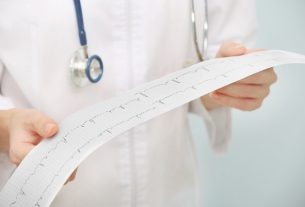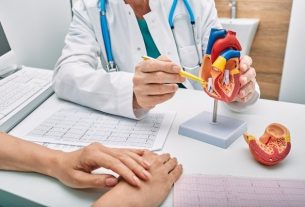Cardiac arrhythmia is a change in the rhythm and/or frequency of the heartbeat, causing symptoms such as palpitations, irregular or slow heartbeats, chest pain, dizziness or fainting. Under normal conditions, the heart rate at rest is 60 to 100 beats per minute.
Cardiac arrhythmia can cause the heart to beat faster, slower or out of a regular rhythm, and is caused by anxiety, stress, hyperthyroidism, anemia, atherosclerosis or heart valve disease.
The treatment of cardiac arrhythmia is carried out by a cardiologist and varies according to the type of arrhythmia, and may involve the use of antiarrhythmic medications, surgery or placement of a pacemaker.

Symptoms of cardiac arrhythmia
The main symptoms of cardiac arrhythmia are:
- Frequent palpitations or racing heart;
- Irregular or slow heartbeat;
- Feeling of lump in the throat;
- Dizziness and/or fainting;
- Feeling of weakness or easy tiredness;
- Chest pain;
- Shortness of breathe;
- Mental confusion;
- General malaise.
These symptoms may vary according to the type of arrhythmia and should always be evaluated by a cardiologist, who should request tests to identify the arrhythmia and, thus, indicate the most appropriate treatment. Know how to identify all the symptoms of cardiac arrhythmia.
How to confirm the diagnosis
The diagnosis of cardiac arrhythmia is made by the cardiologist through the evaluation of symptoms, health history and cardiac auscultation, in which the doctor listens to the heartbeat through the stethoscope.
Make an appointment with a cardiologist in the nearest region:
Taking care of your health has never been easier!
Furthermore, the doctor may recommend tests to assess the health of the heart and identify the type of arrhythmia, such as an electrocardiogram, echocardiogram, 24-hour Holter monitor, exercise stress test, electrophysiological study and the TILT test, for example. See more about exams that evaluate the heart.
Types of arrhythmia
The main types of cardiac arrhythmia are:
1. Tachyarrhythmia
Tachyarrhythmia is a type of cardiac arrhythmia in which, in addition to the heart beating an abnormal rhythm, the frequency of the heartbeat is greater than 100 beats per minute at rest, in the case of adults.
Read too: Heart Rate Calculator
2. Bradyarrhythmia
Bradyarrhythmia is a type of cardiac arrhythmia in which the resting heart rate is less than 60 beats per minute in adults, most frequently affecting the elderly, although it can occur in people at any age.
This type of arrhythmia occurs due to a failure in the heart’s electrical conduction system or damage to the sinus node, due to the natural aging of the body or due to genetic, hereditary problems or heart disease, for example.
3. Ventricular arrhythmia
Ventricular arrhythmia is a type of tachyarrhythmia in which the stimulus that causes the heartbeat appears in the ventricles or lower chambers of the heart, causing the heart to beat faster than normal at rest. Understand better what it is and the symptoms of ventricular arrhythmia.
4. Atrial fibrillation
Atrial fibrillation is the most common type of cardiac arrhythmia, being classified as a subtype of supraventricular arrhythmia, that is, of the atria and occurs due to a disorganization of electrical activity in the atria of the heart, resulting in an increase in heart rate that can reach up to 400 heartbeats per minute at rest. Learn more about atrial fibrillation.
5. Paroxysmal supraventricular tachycardia
Paroxysmal supraventricular tachycardia occurs due to problems in electrical signals that begin in the upper chambers of the heart, called atria, and reach the lower chambers, called ventricles.
This type of arrhythmia usually appears suddenly and disappears quickly, causing extra heartbeats and a feeling of a racing or racing heart. Understand better what supraventricular tachycardia is.
6. Sinus arrhythmia
Sinus arrhythmia is a type of arrhythmia that causes an increase in heart rate when the person inhales air and a decrease in heart rate when exhaling air, being considered normal, being very common in babies, children and adolescents, and does not indicate any health problem. .
However, when it appears in adults or the elderly, it may be related to the use of digitalis medications, traumatic intracranial hypertension, atherosclerotic heart disease or atrioventricular block, for example. See other causes of sinus arrhythmia.
Possible causes
Cardiac arrhythmia can occur due to several situations, which may or may not be directly related to the heart.
The main causes of cardiac arrhythmia are:
- Genetic factors;
- Anxiety or stress;
- Severe hypothyroidism;
- Smoking habit;
- Obstructive sleep apnea;
- Diabetes or high blood pressure;
- Anemia;
- Imbalance of electrolytes in the blood;
- Consume excessive caffeine or alcohol, abuse drugs, or use medications such as digoxin or nasal decongestants.
In addition, cardiovascular diseases, such as congenital malformations, Chagas disease, atherosclerosis, cardiomyopathy, valvular heart disease, coronary artery disease, heart attack or scarring in the heart caused by a previous heart attack can also increase the risk of cardiac arrhythmia.
Read too: Cardiomyopathy: what it is, symptoms, types, causes and treatment
How the treatment is carried out
Treatment for cardiac arrhythmia may vary according to the cause of the change, severity of the arrhythmia, how often it occurs, the person’s age and whether there are other symptoms present.
The main treatments for arrhythmia are:
1. Lifestyle changes
In milder cases, the doctor may only recommend changes in lifestyle, in which the person should try to have a healthier and more balanced diet and practice physical activity on a regular basis.
Furthermore, it is important to look for activities that help you relax, especially when you notice a change in your heartbeat.
2. Treating slow heartbeat
Arrhythmia that causes slow heartbeats, called bradycardia, when it does not have a cause that can be corrected, treatment must involve the placement of a pacemaker to help regulate the heartbeat, as there are no medications that can speed up the heart. reliably. Find out how the pacemaker works.
3. Treating fast heartbeat
In the case of arrhythmia that causes accelerated heartbeats, the treatments that can be done are:
- Use of antiarrhythmic medication, Depending on the type of arrhythmia, specific medications may be indicated. Examples of antiarrhythmic drugs are amiodarone, verapamil or atenolol. Each medication has a specific indication;
- Use of anticoagulant medications such as warfarin or the class of NOACs (new oral anticoagulants) to prevent the formation of blood clots that can cause embolism;
- Ablation surgery which is a procedure that aims to remove or destroy an electrical signaling pathway in the heart that is altered and that may be the reason for the arrhythmia;
- Pacemaker placementespecially in cases of slow heart rate in order to coordinate electrical impulses, improving their functioning and controlling the frequency of the beats;
- Cardiodefibrillator implantation to monitor heartbeats continuously and detect any serious arrhythmia. This device sends a specific electrical charge to the heart to normalize the heart’s rhythm in case of complex arrhythmia when there is a risk of cardiac arrest.
In some cases, your doctor may recommend surgery for bypass coronary artery if the arrhythmia is caused by problems with the coronary arteries, which are responsible for irrigating the heart, allowing the correction and redirection of blood flow from the affected coronary artery. Find out how surgery is performed bypass coronary.
Possible complications
Some complications of cardiac arrhythmia are increased formation of blood clots that can lead to a stroke or heart attack, cardiac arrest or even sudden death, for example.
Complications depend on the type of arrhythmia and, therefore, it is important to consult a cardiologist whenever symptoms of arrhythmia appear, so that the type can be identified and the most appropriate treatment can be indicated, in order to avoid complications that can be life-threatening.
Read too: Sudden illness: what it is, symptoms, causes (and how to avoid it)

Sign up for our newsletter and stay up to date with exclusive news
that can transform your routine!
Warning: Undefined array key "title" in /home/storelat/public_html/wp-content/plugins/link-whisper-premium/templates/frontend/related-posts.php on line 12
Warning: Undefined array key "title_tag" in /home/storelat/public_html/wp-content/plugins/link-whisper-premium/templates/frontend/related-posts.php on line 13



